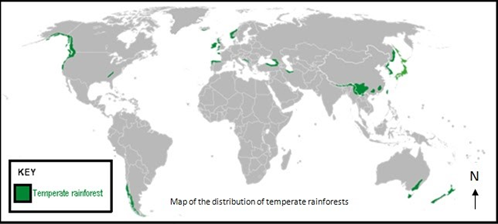TAG: GS-1: GEOGRAPHY
THE CONTEXT: The study published by researchers at the University of Leeds in the United Kingdom shows that under this scenario, by the year 2100, a team of researchers has found that more than 68% of temperate rainforests will be lost due to climate change under a ‘business as usual’ scenario.
EXPLANATION:
About the Temperate Rainforests:
- The temperate rainforest biome is a type of rainforest biome found in temperate climates. To put it simply, temperate rainforests receive heavy rainfall but have cooler average temperatures than tropical rainforests.
- Temperate rainforests are located along some coasts in temperate regions. The largest temperate rainforests are located on the Pacific coast of North America.

- They extend from Oregon to Alaska for about 1,200 miles.
- Smaller temperate rainforests also exist.
- They can be located on the southeast coast of Chile, South America.
- A few other coastal strips exist that have temperate rainforests such as small parts in the U.K., New Zealand, Japan, South Australia and Norway.
Current Status of Temperate Rainforests:
- 43% of the existing biome has already been lost to deforestation.
- Only 37% of primary old-growth forests remain globally.
- Europe has almost no intact temperate rainforests left.
Climate Vulnerability of Temperate Rainforests:
- Temperate rainforests are characterized by mild climates or temperatures.
- Essentially, these areas do not experience extremely cold or extremely hot temperatures.
- Temperate rainforests have two different seasons.
- One season (winter) is quite long and wet, and the other (summer) is short, dry and foggy.
- Throughout the long-wet season, the temperature hardly falls below freezing point, which is 0°C and 32°F.
- Throughout the short, dry and foggy season, the temperature hardly exceeds 27°C or 80°F.
- This pretty much explains why this biome is referred to as temperate rainforest.
- Also in summer, when it’s relatively dry, the weather is considerably cool as the fog supplies sufficient moisture to enable the rainforest to thrive.
- Ideally, the fog contributes 18-30 cm (7-12 in) of precipitation every summer.
- These biomes are so mild due to their closeness to the ocean on one side and mountain ranges on the other.
- During winter months, the ocean water emits heat, leaving the coastal areas warmer and absorbs heat during summer months, leaving the coastal areas cooler.
- Considering the word ‘’rain” is found in the word ‘’rainforest,” it tells you right off that this biome receives plenty of rainfall.
- The average annual precipitation of a temperate rainforest biome is 200cm.
- In much warmer areas, the average precipitation goes up to about 350 cm annually.
- oaks, beeches, walnut trees, lime trees, sycamores, aspens, elms, tulip trees, and birches.
Wildlife of Temperate Rainforests:
- Compared to tropical rainforest biomes, temperate rainforest biomes harbor very few mammals due to the absence of a series of sophisticated layers and the fact that the vegetation is seasonal.
- In summer months, the animal species of this ecosystem feed particularly on winged seeds and wall nuts that keep for a long duration.
- Fruits produced by the rose tree, apple tree, gooseberry, Hawthorne, and others almost always ripen at the same time (during late summer) and are chiefly used in the course of summer for fat storage.
- There is a huge diversity of life in temperate rainforest biomes.
- Frogs, turtles, insects, birds, spiders and salamanders are just some of the animal varieties found here.
- Bird species like cardinals, broad-winged hawks, pleated woodpeckers and snowy owls exist in this biome.
- Some of the mammals present in this biome include raccoons, porcupines, red foxes, white-tailed deer, and opossums.
Global Recommendations:
- Immediate and stringent climate mitigation strategies are needed.
- Focus on achieving the 2°C global warming limit under the Paris Agreement.
- Enhanced conservation efforts for remaining temperate rainforests.
Source:
Spread the Word
